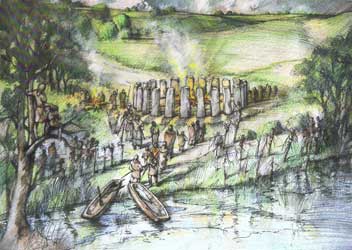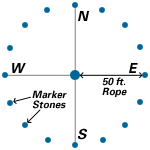This activity is designed to show students, or
 |
Build a Stone Circle
Make your own stone circle following these simple instructions and then bring it to life.
Click here for PDF download
|
anyone really, the progression of the Sun over the course of the year by creating an astronomical calendar. Stonehenge is one of the best known astronomical calendars in the world, especially in marking the Summer Solstice.
The principle behind an astronomical calendar is very simple. In fact, every day people see it happen but usually fail to take notice. With each passing day, the apparent rising and setting horizon point of the sun changes. You might notice this if you are outside close to sunrise or sunset each day. Take note of the sun's location at each day as the same time. You will see that it "walks" back and forth from north to south over the course of the year.
In the northern hemisphere, the winter solstice marks the southern limit of the setting sun's journey, and the summer solstice is the northern boundary. Closer examination would reveal that, with the exception of the two solstice extremes, every other point on the horizon is crossed twice during the course of the year, once on the southern march and again on the northern return.
To make it easier to watch, at a minimum, an astronomical calendar only requires a fixed reference point for viewing, and another fixed reference point marking the position of the rising and/or setting sun on the horizon.
To create your own Stonehenge type circle we are going to mark off the location of the sun as it sets every 7 days. You could do this as the sun rises each morning, but not too many people want to get up that early! :)
Materials needed:
- An outside space, hopefully offering a 360º horizon view. You will need to leave markings on the ground for awhile. Find a place where they can be left undisturbed, part of the school parking lot, part of a playing field, an off site location.
- Center stake for a reference point.
- 50 feet of rope.
- 20 to 30 marker stones/small stakes or another means to mark your locations.
- A compass.
Steps to build your own Stonehenge circle
 |
| Stonehenge Circle |
1. Anchor a reference stake at the center point of the circle and place the compass on top of it.
2. Determine due north and place a marker at 50 feet north of the center.
3. Repeat the process for east, west, and south. (The rope is used as a guide to insure that all markers are equidistant from the center stake.)
4. Again, using the rope as a guide, place a small marker stone every few feet around the perimeter of the circle.
5. The center of the circle now becomes the fixed reference point and the westward facing perimeter is where you will be placing the sunset markers.
6. The calendar can be started at any time, but the solstice sunsets are the most fun. (The Northern Hemisphere is the reference for the following dates. The summer solstice, which happens on June 21 or 22 each year, has the longest daylight time. It is also the first day of summer. The winter solstice, on December 21 or 22, has the shortest, and officially kicks off winter. The autumn equinox occurs on September 21 or 22; the spring equinox occurs on March 20 or 21.)
7. Mark the point of sunset with a pole, stake, or other (not easily moved) marker.
8. Tag the marker with the date of sunset.
9. Repeat the process every seven days. Over the weeks and months note that the sun appears to "walk" faster at some times of the year than others.
10. When you have finished (you could do this over the entire school year) you will have a working astronomical calendar.
Non-construction alternatives
If you do not have a large space to create your Stonehenge circle, then you can try the following ideas:
- Take a snapshot of the western skyline and tape it to the wall by a western-facing window. With a felt-tip marker, draw an arrow on the photo corresponding to the point of sunset and note the date. Repeat the process.
- Window marks: (This takes two people.) Standing at the same point in the room of a western-facing window, have the other person make a small mark on the glass where the sun sets. Note the date and repeat the process on a weekly basis.
Thank you to the Family Education Network, Inc. for the basic idea and structure of this exercise.
|